Chassis-by-Wire Research: China’s Brake-by-Wire Assembly Rate Is only 2%, Indicating Huge Growth Potentials
With the mass production of L3-L4 autonomous driving, the necessity of Chassis-by-Wire has become increasingly prominent. What is the status quo of Chassis-by-Wire? What is the more advanced product form? Who will lead this market?
1. Brake-by-Wire takes the lead in mass production, and Bosch dominates the field
There are two key Chassis-by-Wire products: Brake-by-Wire and Steer-by-Wire. Brake-by-Wire has taken the lead in mass production thanks to the demand from new energy vehicles and L3 autonomous driving. China's Brake-by-Wire assembly rate was 1.6% in 2020, and it is expected to exceed 2.5% in 2021.

In 2020, Bosch's Brake-by-Wire products (iBooster, iBooster 2.0, IPB) seized a market share of over 90%, signaling an absolute dominant position.
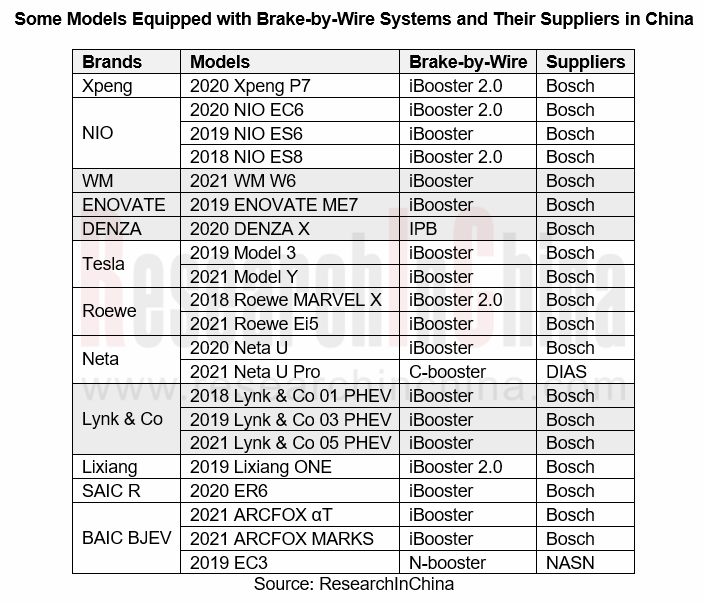
2. In the EMB era, Brembo, Mando, Haldex, and EA Chassis get a head start
Currently, Brake-by-Wire is mainly divided into Electro-Hydraulic Brake (EHB) and Electro-Mechanical Brake (EMB).
? EHB evolves from the traditional hydraulic brake system. Compared with the traditional hydraulic brake system, EHB boasts a more compact structure and better braking efficiency. It is currently the main mass production solution of the Brake-by-Wire system. Bosch IPB/iBooster, Continental MK C1/MK C2, ZF TRW IBC, Bethel Automotive Safety Systems WCBS, etc. are all EHB solutions.
? EMB completely abandons brake fluid and hydraulic pipelines that are seen in the traditional brake system, but uses the motor to drive the brake to generate the braking force. It is a true Brake-by-Wire system and is expected to become the development trend.
At present, there are no mature EMB products on the market. Major foreign companies such as Brembo, Mando, and Haldex have displayed or released related products, and they may get a head start in future marketization.
In April 2021, Brembo released its Brake-by-Wire product at the Shanghai Auto Show. Brembo has been studying the Brake-by-Wire technology based on mechatronics since 2001.
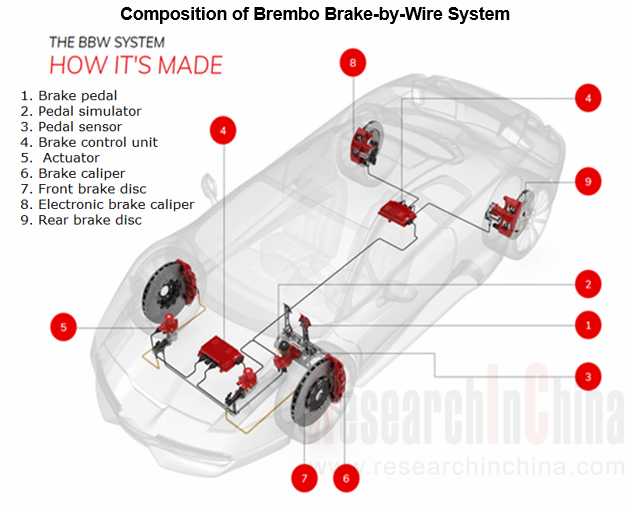
Mando announced its Brake-by-Wire technology at CES 2021, which is composed of 4 units of EMB (Electro Mechanical Brake), mounted on “4-corner module (4 wheels)”, “E-Brake-Pedal (Electronic brake pedal)”, and DCU (Domain Control Unit).
In May 2020, Zhejiang Vie Science & Technology Co., Ltd. and Haldex invested RMB15 million each in establishing Suzhou Haldex Vie, which is dedicated to the production and sale of EMB products. The EMB launched by Haldex Vie targets the commercial vehicle market and can be used on city buses, coaches, trucks and tractors.
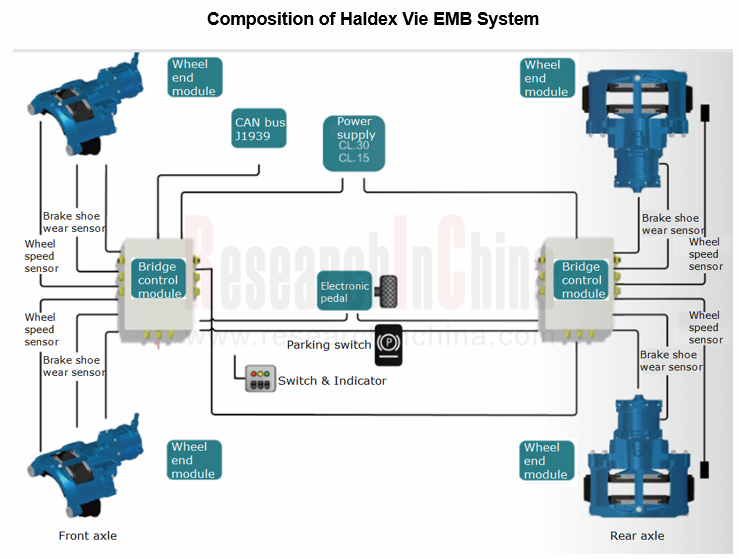
Among domestic automakers, EA Chassis, a subsidiary of Great Wall Motor, has researched EMB by itself and released related products during the 2021 Shanghai Auto Show.
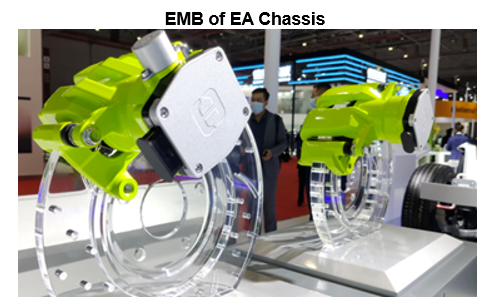
3. Steer-by-Wire represents the next-generation development route
Compared with the booming Brake-by-Wire market, Steer-by-Wire seems too quiet. At present, only four production models of Infiniti adopt mechanically redundant Steer-by-Wire (namely Direct Adaptive Steering? (DAS)) from Kayaba.
DAS retains the mechanical transmission steering mode. When Steer-by-Wire fails, the driver can take over the control. But for autonomous driving, the backup & redundant technology roadmap of the electronic control system may be a better choice.
The electronic control system backup & redundant steering (SBW) uses multiple motor controllers at the actuator (steering mechanism) to achieve redundancy. At the steering wheel, multiple sensors are arranged to enable the redundancy of the input signal. Therefore, it can completely remove the mechanical connection between the steering wheel and steering gear. On this basis, it is possible for autonomous vehicles to let the steering wheel extend or retract, which can diversify the layout of the cockpit.
4. SBW will see mass production in 2022-2023, with Bosch and Mando taking the lead in layout
Currently, SBW is still dominated by foreign companies. Bosch, Mando, JTEKT, Nexteer, Schaeffler, etc. have taken the lead in the layout, and they will conduct mass production in 2022-2023.
Bosch will launch SBW- Motor Redundant Backup System in 2023
Bosch adopts the redundant backup technology roadmap for the electronic control system. Its Steer-by-Wire system was first unveiled at the 2019 Shanghai Auto Show, but the product is expected to be applied in 2023.
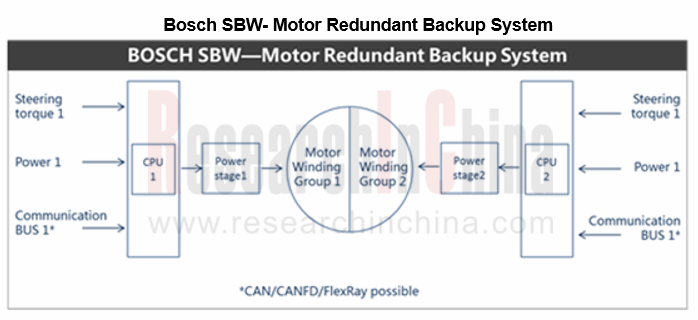
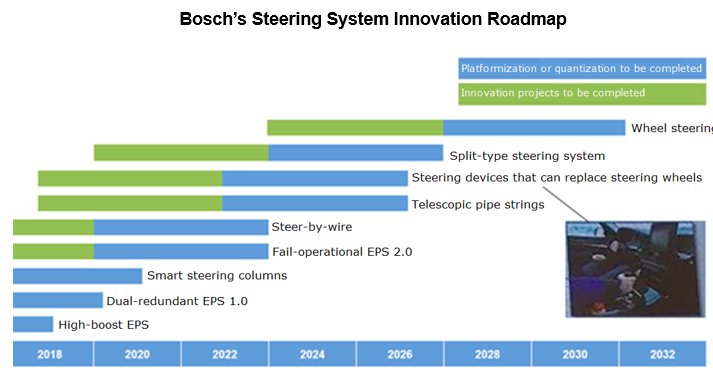
Mando will mass-produce Steer-by-Wire products in 2022
In January 2021, Mando unveiled its new vision based on safety and freedom, the “Freedom in Mobility”, at CES 2021. Under this vision, Mando demonstrated the “x-by-Wire” technology including Mando’s BbW (Brake-by-Wire) and SbW (Steer-by-Wire)
Mando built its SbW on a redundant E/E architecture and it can be continuously upgraded. It will be mass-produced at the Opelika plant in Alabama, North America, at first, in 2022.
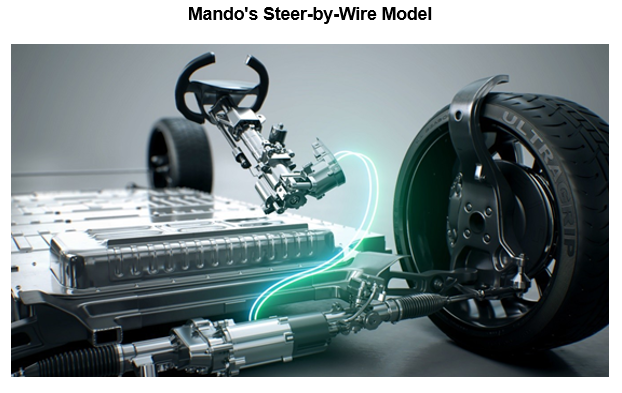
Summary:
On the whole, companies that deploy Brake-by-Wire and Steer-by-Wire simultaneously are more likely to provide users with integrated Chassis-by-Wire solutions, and will grab more lucrative opportunities before autonomous driving is implemented. At present, such companies include Bosch, CNXMotion (a joint venture between Continental and Nexteer), ZF, Mando and other foreign companies, as well as Chinese companies like NASN.
In addition, China-based Great Wall Motor has also started its layout. It conducts independent research and development of Brake-by-Wire and Steer-by-Wire through its two subsidiaries, EA Chassis and HYCET. In 2023, Great Wall Motor will commercialize smart Chassis-by-Wire which integrates a new EEA, Steer-by-Wire, Brake-by-Wire, Shift-by-Wire, Throttle-by-Wire and Suspension-by-Wire to dabble in L4 autonomous driving.
OEMs and Tier 1 Suppliers' Cost Reduction and Efficiency Enhancement Strategy Analysis Report, 2025
ResearchInChina released the "OEMs and Tier 1 Suppliers' Cost Reduction and Efficiency Enhancement Strategy Analysis Report, 2025", summarizing hundreds of cost reduction strategies to provide referen...
Automotive Fixed Panoramic Sunroof and Smart Roof Research Report, 2025
With the intelligent application of car roofs as the core, this report systematically sorts out a series of new products such as fixed panoramic sunroof/openable sunroof, ceiling screen, roof ambient ...
Automotive-Grade Power Semiconductor and Module (SiC, GaN) Industry Research Report, 2025
SiC/GaN Research: Sales volume of 800V+ architecture-based vehicles will increase more than 10 times, and hybrid carbon (SiC+IGBT) power modules are rapidly being deployed in vehicles.
Sales volume o...
Cockpit Agent Engineering Research Report, 2025
Cockpit Agent Engineering Research: Breakthrough from Digital AI to Physical AI
Cockpit Agent Engineering Research Report, 2025 starts with the status quo of cockpit agents, summarizes the technical ...
Prospective Study on L3 Intelligent Driving Technology of OEMs and Tier 1 Suppliers, 2025
L3 Research: The Window of Opportunity Has Arrived - Eight Trends in L3 Layout of OEMs and Tier 1 Suppliers
Through in-depth research on 15 OEMs (including 8 Chinese and 7 foreign OEMs) and 9 Tier 1 ...
China Commercial Vehicle IoV and Intelligent Cockpit Industry Research Report 2025
Commercial Vehicle IoV and Cockpit Research: The Third Wave of Passenger Car/Commercial Vehicle Technology Integration Arrives, and T-Box Integrates e-Call and 15.6-inch for Vehicles
I. The third wav...
Intelligent Vehicle Electronic and Electrical Architecture (EEA) and Technology Supply Chain Construction Strategy Research Report, 2025
E/E Architecture Research: 24 OEMs Deploy Innovative Products from Platform Architectures to Technical Selling Points
According to statistics from ResearchInChina, 802,000 passenger cars with domain...
Research Report on Intelligent Vehicle Cross-Domain Integration Strategies and Innovative Function Scenarios, 2025
Cross-Domain Integration Strategy Research: Automakers' Competition Extends to Cross-Domain Innovative Function Scenarios such as Cockpit-Driving, Powertrain, and Chassis
Cross-domain integration of ...
China Autonomous Driving Data Closed Loop Research Report, 2025
Data Closed-Loop Research: Synthetic Data Accounts for Over 50%, Full-process Automated Toolchain Gradually Implemented
Key Points:From 2023 to 2025, the proportion of synthetic data increased from 2...
Automotive Glass and Smart Glass Research Report, 2025
Automotive Glass Report: Dimmable Glass Offers Active Mode, Penetration Rate Expected to Reach 10% by 2030
ResearchInChina releases the Automotive Glass and Smart Glass Research Report, 2025. This r...
Passenger Car Brake-by-Wire (BBW) Research Report, 2025
Brake-by-Wire: EHB to Be Installed in 12 Million Vehicles in 2025
1. EHB Have Been Installed in over 10 Million Vehicles, A Figure to Hit 12 Million in 2025.
In 2024, the brake-by-wire, Electro-Hydr...
Autonomous Driving Domain Controller and Central Computing Unit (CCU) Industry Report, 2025
Research on Autonomous Driving Domain Controllers: Monthly Penetration Rate Exceeded 30% for the First Time, and 700T+ Ultrahigh-compute Domain Controller Products Are Rapidly Installed in Vehicles
L...
China Automotive Lighting and Ambient Lighting System Research Report, 2025
Automotive Lighting System Research: In 2025H1, Autonomous Driving System (ADS) Marker Lamps Saw an 11-Fold Year-on-Year Growth and the Installation Rate of Automotive LED Lighting Approached 90...
Ecological Domain and Automotive Hardware Expansion Research Report, 2025
ResearchInChina has released the Ecological Domain and Automotive Hardware Expansion Research Report, 2025, which delves into the application of various automotive extended hardware, supplier ecologic...
Automotive Seating Innovation Technology Trend Research Report, 2025
Automotive Seating Research: With Popularization of Comfort Functions, How to Properly "Stack Functions" for Seating?
This report studies the status quo of seating technologies and functions in aspe...
Research Report on Chinese Suppliers’ Overseas Layout of Intelligent Driving, 2025
Research on Overseas Layout of Intelligent Driving: There Are Multiple Challenges in Overseas Layout, and Light-Asset Cooperation with Foreign Suppliers Emerges as the Optimal Solution at Present
20...
High-Voltage Power Supply in New Energy Vehicle (BMS, BDU, Relay, Integrated Battery Box) Research Report, 2025
The high-voltage power supply system is a core component of new energy vehicles. The battery pack serves as the central energy source, with the capacity of power battery affecting the vehicle's range,...
Automotive Radio Frequency System-on-Chip (RF SoC) and Module Research Report, 2025
Automotive RF SoC Research: The Pace of Introducing "Nerve Endings" such as UWB, NTN Satellite Communication, NearLink, and WIFI into Intelligent Vehicles Quickens
RF SoC (Radio Frequency Syst...